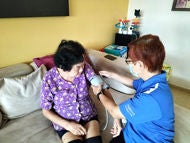What is - Lung Cancer
What is lung cancer?

Lung cancer is a disease that begins in the lungs. Lungs are part of the respiratory system that works together to help you breathe. The respiratory system’s main function is to move fresh air into your body while removing waste gases. Lung cancer occurs when there is an uncontrolled growth of abnormal cells in the lung which can interfere with normal lung function. The abnormal cells can pass from the original part of the lung to other parts of the body, such as the opposite lung, our lymph nodes, bones, liver and more.
What are the types of lung cancer?
- Non-small cell lung cancer (NSCLC): NSCLC accounts for approximately 85% of all lung cancers and arises from a type of cell that lines the surface of organs (epithelial cells). Types of NSCLC include adenocarcinoma, squamous cell carcinoma and large cell carcinoma.
- Small cell lung cancer (SCLC): SCLC accounts for 15% of all lung cancers and is strongly associated with cigarette smoking. It grows and spreads quickly to other parts of the body, including the lymph nodes.
What is the prevalence of lung cancer?
According to the Singapore Cancer Registry, over a five-year period, from 2018 to 2022, approximately 9,000 cases of lung cancer were diagnosed in Singapore. Lung cancer is the second most common cancer in men and third most common in women. Furthermore, it is the leading cause of cancer death in men and second leading cause of cancer death in women. Lung cancer is more commonly diagnosed in individuals above 40 years old, however, the disease can occur in younger individuals.
Symptoms of Lung Cancer
What are the symptoms of lung cancer?
Early-stage lung cancer may not cause any noticeable symptoms.
Common symptoms of lung cancer at a more advanced stage include:
- Persistent cough that gets worse over time
- Shortness of breath
- Blood in the sputum
- Constant chest pain (may occur in association with a chronic cough)
- Recurrent chest infection and fever
- Weight loss
When should you see a doctor?
Make an appointment with your doctor if you have any signs or symptoms that worry you.
Lung Cancer - How to prevent
How is lung cancer prevented?

As smoking is one of the main causes of lung cancer, the best way to minimise the risk of developing lung cancer is to avoid smoking. There are several ways to do this:
- Primary Prevention: If you have never smoked, don’t start.
- Secondary Prevention: If you are a smoker, stop smoking. Stopping smoking at any age can help to reduce the risk of developing lung cancer. Avoid exposure to second-hand smoke (from others around you who may smoke).
- Screening: If you are aged between 55 to 74 and have smoked 30 or more pack years* and are continuing to smoke or quit less than 15 years ago, you can consider undergoing a low dose CT scan to screen for lung cancer.
*Pack years are calculated by multiplying the number of cigarette packs smoked daily by the number of years smoking.
It is also recommended that you eat a diet rich in fruits and vegetables and to exercise regularly.
Lung Cancer - Causes and Risk Factors
What causes lung cancer?
A number of different behaviours and environmental exposure are known to increase the risk of developing lung cancer such as:
- Cigarette, Pipe or Cigar Smoking: Cigarette smoking is the most common risk factor for lung cancer and is estimated to be responsible for between 80% to 90% of deaths related to lung cancer. The risk of lung cancer developing in a smoker is 15-30 times more than for a non-smoker and increases the longer the duration and/or quantity smoked.
- Industrial Hazards: Exposure to certain harmful chemicals and minerals increases the risk of lung cancer (e.g. asbestos, coal gas, chromates, nickel, arsenic, vinyl chloride, mustard gas, radon, by products of uranium, mining processing).
- Passive Smoking: Non-smokers who are exposed to second-hand smoke increase their risk of developing lung cancer by 20-30%.
How does smoking causes lung cancer?
Research has shown that cigarette smoke is packed with cancer-causing substances, called carcinogens. When cigarette smoke is inhaled, the carcinogens cause damage to the cells that line the lungs. As healthy cells are exposed to the smoke, they get damaged and eventually transform into cancerous cells.
Despite the strong association of smoking with lung cancer, nearly half of the lung cancer cases in Singapore occur in people who have never smoked. Given the higher proportion of never-smokers who develop lung cancer in Singapore and Asia, which is a stark contrast to the West, it is likely that additional genetic susceptibilities or environmental and lifestyle risks remain unidentified. Family history of lung cancer has also been associated with a higher lung cancer risk. Further evidence generated from local population research will enable us to better understand causative links between lung cancer and the East Asian, never-smoker phenotype, as well as to develop lung cancer screening guidelines in Singapore.
What are the possible complications of lung cancer?
Lung cancer can lead to complications such as:
Breathlessness
Patients may feel breathless if the lung cancer grows and blocks major airways. Lung cancer can also lead to fluid accumulation around the lungs and heart, making it more difficult for the lungs to expand during inhalation.
Coughing blood
Lung cancer can result in bleeding in the airways, which may cause patients to cough up blood and, in some cases, can be severe. However, treatments are available to manage bleeding.
Pain
Late-stage lung cancer that has spread, such as to the lining of the lung or to other areas, can lead to pain. Inform your doctor if you experience any pain who can recommend treatments to help manage it.
Fluid in the chest
Lung cancer can lead to fluid accumulation in the chest, known as pleural effusion. This fluid gathers in the pleural space, an area surrounding the affected lung within the chest cavity. Pleural effusion can result in breathlessness. However, there are treatments available to drain the fluid and reduce likelihood of it recurring.
Cancer spread
Lung cancer often spreads to other parts of the body such as the brain and bones, causing pain, nausea, headaches or other symptoms depending on the affected organ. Once it spreads beyond the lungs, it is typically considered incurable. However, treatments are available to help manage the symptoms and prolong survival.
Diagnosis of Lung Cancer
How is lung cancer diagnosed?

Tests and procedures used to diagnose lung cancer include a combination of imaging tests and biopsy of an area of abnormal growth detected on a scan, or on clinical examination.
Initial imaging tests
- Chest X-ray: A chest X-ray is used to identify abnormalities in the lungs that can then be investigated further with a CT scan.
- Computerised Tomography Scan (CT) Scan: CT scans use x-ray beams rotated around the body to produce a series of images that produces a complete picture of the part of the body that is being scanned. A CT scan can show details such as the size, shape and position of any lung tumours. It can also help detect areas where the cancer may have spread to, such as the lymph nodes between the lungs or in the neck, or other organs such as the adrenal glands, liver and brain.
Tests to determine the stage of lung cancer
After confirming the diagnosis of lung cancer, further tests may be performed to determine if the cancer has spread to other parts of the body. This information is used to decide the stage of lung cancer. Different stages of lung cancer require different types of treatment.

Examples of these tests:
- Bone Scan: A bone scan can detect if cancer has spread from the lung to the bones. In this procedure, a small amount of radioactive material called a tracer is injected and a scan is done to see how the tracer is absorbed, as this can indicate the presence of cancer spread in the bones.
- Positron Emission Tomography (PET) Scan: During a PET scan, a radioactive glucose solution is injected into the body. This is absorbed by cells in the body that are active and growing quickly, indicating the possible presence of cancer in these areas. The areas of glucose uptake can be identified with a special camera, which indicates active areas of growth.
- Magnetic Resonance Imaging (MRI) Scan: Like CT scans, MRI scans provide detailed images of the body and are most often used to look for possible spread of lung cancer to the brain or spinal cord. MRI scans use radio waves and strong magnets to produce images instead of x-rays.
- Mediastinal staging: In patients suspected to have stage 3 lung cancer, additional biopsy procedures may be recommended to determine if the mediastinal lymph nodes (located between both lungs) are affected by lung cancer. This will help doctors to decide between surgery or radiotherapy for the patient. Examples of these biopsy procedures are:
- Endobronchial Ultrasound: In this test, a bronchoscope, which is a device used to see the inside of the airways and lungs, is fitted with an ultrasound transducer. If suspicious lymph nodes are identified, a needle is passed through the device to obtain a biopsy.
- Mediastinoscopy: This is a minor surgical procedure done under general anaesthesia to get samples from lymph nodes in the chest. A small cut is made in the front of the neck and a small lighted device is inserted in the area behind the sternum (breast bone) to identify lymph nodes in the chest to be removed for biopsy.
- Video-Assisted Thoracoscopic Surgery (VATS): This is a surgical procedure done under general anaesthesia to get samples from lymph nodes in the chest. One or more small incisions are made on the side of the chest to allow the surgeon to use a camera to identify lymph nodes inside the chest to be removed for biopsy.
Stages of lung cancer
Small cell lung cancer (SCLC) and non-small cell lung cancer (NSCLC) are staged differently.
SCLC
- Limited stage: Cancer cells are only on one side of the chest and can be encompassed and treated with radiotherapy.
- Extensive stage: Cancer cells have spread to the other side of the lungs and/or other parts of the body.
NSCLC
- Stage 1-3: Cancer cells have grown into lungs at the area they originated, and may have spread to nearby lymph nodes but not to the other side of the lungs nor other parts of the body.
- Stage 4 (metastatic): Cancer cells have spread to other parts of the body away from the original lung tumour. Common sites of spread include the other lung, or the brain, liver, bone and adrenal gland.
Molecular/ Biomarker testing (for NSCLC)
- Certain types of NSCLC may be further divided into different subtypes based on molecular testing of the lung biopsy specimen for certain genes or proteins. These results are used to determine treatment, particularly in stage 4 NSCLC.
- Molecular testing is usually done on biopsy samples. However, in some situations when the biopsy specimen is not available, the quantity is not enough for further tests, or where the biopsy cannot be performed, a blood test can be done to determine the molecular profile of the cancer. This is referred to as a “liquid biopsy”.
Treatment for Lung Cancer
How is lung cancer treated?

Treatment for lung cancer depends on the type of lung cancer, stage of cancer and general health and fitness of the patient. An individual with cancer should be assessed by a specialist to determine which modality of treatment is best suited for them.
Types of treatment
- Surgery: Surgery for lung cancer involves the removal of part or all of a lung affected by cancer to stop the spread of the disease. It is usually recommended for early-stage lung cancer where the tumour is confined to one area and can be safely removed.
- Chemotherapy: Refers to the use of drugs to destroy growing cancer cells, by preventing them from growing and dividing, and can be given either intravenously (through a vein) or by tablets.
- Radiotherapy: Uses high-energy x-rays to kill cancer cells in a specific area, while minimising damage to normal cells nearby. Depending on the stage of the cancer, it may be used as the main treatment. In early-stage lung cancer, stereotactic body radiotherapy (SBRT) is used as an alternative to surgery. In locally advanced lung cancer, radiation is sometimes given along with chemotherapy. It may also be used after lung cancer surgery if there are any areas of cancer that could not be removed. Volumetric modulated arc therapy (VMAT) and intensity modulated radiotherapy (IMRT) can reduce radiation doses to normal organs. Radiosurgery and SBRT may also be used to treat cancers that have spread to other organs in some cases.
- Targeted therapy: Refers to drugs which are designed to ‘target’ specific changes in the cancer cells that help them to grow, divide and spread. Targeted therapy is usually recommended based on the molecular profile of lung cancer.
- Immunotherapy: Refers to a group of drugs called immune checkpoint inhibitors (ICI) which work by helping the body’s immune system recognise and destroy cancer cells.
Treatment by type and stage of lung cancer
SCLC
Limited stage disease is usually treated with a combination of chemotherapy and radiotherapy to the lungs and mediastinal lymph nodes. After completion of chemoradiation, radiotherapy to the brain may be recommended to reduce the risk of cancer relapse in the brain. Extensive stage disease is usually treated with a combination of chemotherapy and immunotherapy. Some patients may also be treated with radiotherapy depending on their sites of spread and response to treatment.
NSCLC
- Stage 1 and 2: Surgery to remove the cancer is the preferred treatment for stage 1 and stage 2 NSCLC. In some cases, the initial surgery may be preceded or followed by post-operative therapy. This may include chemotherapy, targeted therapy, or immunotherapy. The most common surgery for lung cancer is lobectomy, which involves the removal of the affected lobe of the lung. Other types of operations such as a sub lobar resection (removal of less than a lobe of the lung) or pneumonectomy (removal of the entire lung) are occasionally performed depending on the patient’s underlying health status as well as the size and location of the patient’s lung cancer. Whenever possible, these operations are performed by video-assisted thoracoscopic surgery (VATS) using small incisions on the chest to facilitate recovery after surgery. Radiation therapy may be recommended for people who are not suitable for surgery due to severe lung disease or other underlying medical problems.
- Stage 3: Management of stage 3 lung cancer usually requires multidisciplinary care as it comprises a combination of surgery, radiotherapy, chemotherapy and immunotherapy. Some patients with stage 3 lung cancer may be unsuitable for surgery, such as those where the cancer has spread to multiple lymph nodes in the middle of both lungs (‘mediastinum’) or where the cancer is very close to vital organs such as the heart or big blood vessels. For these patients a combination of chemotherapy with radiotherapy to the lungs and lymph nodes may be recommended, followed by immunotherapy treatment.
- Stage 4: Treatment of stage 4 NSCLC depends on the subtype (squamous or non-squamous) as well as the molecular profile of the tumour, and comprises various options such as chemotherapy, targeted therapy and/or immunotherapy.
Side Effects from Treatment
- Surgery: Breathlessness, pain the chest wall, cough and tiredness
- Chemotherapy: Hair loss, fatigue, change in taste, nausea, vomiting and low blood counts
- Radiotherapy: Breathlessness, cough, difficulty swallowing and skin changes
- Targeted therapy: rashes, diarrhoea, paronychia (nail bed infection), nausea, vomiting and oral ulcers
- Immunotherapy: Besides fatigue, the side effects are mainly related to overactivity of the immune system resulting in inflammation of various organs, of which the common ones affected are skin, thyroid, lungs and liver.
FAQs on Lung Cancer
1. What does lung cancer feel like and what are the signs and symptoms?
Early-stage lung cancer may not cause any noticeable symptoms. At a more advanced stage, lung cancer symptoms may include a persistent cough, chest pains, shortness of breath, blood in the sputum, recurrent chest infections and unexplained weight loss.
2. Who are most at risk of developing lung cancer?
Lung cancer risk is influenced by a combination of modifiable and non-modifiable factors. Smoking is the most important modifiable risk factor for lung cancer, as smokers are 15 to 30 times more likely to develop lung cancer than non-smokers. The importance of quitting smoking cannot be overemphasised. In non-smokers, second-hand smoke and environmental exposures at work, such as to asbestos and diesel are also associated with an increased risk for lung cancer. In addition, having a first or second degree relative with lung cancer increases the risk of developing lung cancer.
3. How is lung cancer detected and diagnosed?
Lung cancer is usually diagnosed through imaging tests such as X-rays or CT scans, followed by a biopsy of an area of abnormal growth that is detected on the scans. The tissue samples extracted during the biopsy are sent to the laboratory to be examined to confirm the diagnosis of lung cancer.
4. Can lung cancer be cured?
Lung cancer can be cured in the early stages when the cancer is localised and can be completely removed by surgery. Patients may be given additional treatment before or after surgery to reduce the risk of cancer spread, such as chemotherapy, targeted therapy and/or immunotherapy.
5. Does vaping cause lung cancer?
As vaping is relatively new, its long-term impact on the risk of developing lung cancer is not yet well-established. Nonetheless, vaping devices release harmful chemicals which may damage lung tissue and lead to the development of lung cancer over time.
6. Can you get lung cancer if you don’t smoke?
Yes, you can. Lung cancer among never smokers is common in Asia. Associated modifiable risk factors include exposure to second-hand smoke, excessive consumption of meat, as well as air pollution – particularly tiny PM 2.5 particles. Family history has also been shown to be associated with the development of lung cancer, especially amongst never smoking women of Chinese ethnicity. The growth of lung cancer in never smokers is commonly driven by a single genetic alteration in majority of these individuals. Ongoing local population research will enable us to better understand the connection between lung cancer and the Asian, never-smoker patient profile.
Pre-Surgery Preparation for Lung Cancer
How can you prepare for lung cancer surgery?
Your surgeon will perform a comprehensive medical work-up including physical examination, lung function test, blood tests and scans to see if you are suitable for surgery and advise you on the risks involved. This treatment recommendation is often based on consensus by a group of different specialists' opinions (medical tumour board) which weighs the pros and cons of every treatment strategy.
Before surgery, the anaesthesia team will also assess your fitness for surgery and advise you on various aspects of general anaesthesia and pain control after surgery. As with all surgical procedures, complications can occur during and/or after surgery. Some of these risks and complications are inherent in any operative procedure, especially when general anaesthesia is administered. You should ask your doctors about these risks.
You should stop smoking as soon as possible, ideally at least two weeks before surgery to minimise your risk of developing complications after surgery. You should also inform your doctor if you are on any blood thinning medication or traditional medication, as these need to be stopped prior to surgery to minimise risk of bleeding after surgery. Finally, you should try to walk at least an hour a day prior to surgery, as you will be required to walk after surgery to improve your recovery.
Specialist nurses will also provide pre-surgery counselling.
Post-Surgery Care for Lung Cancer
What can you expect after lung cancer surgery?
Immediately after the surgery, you will have a chest tube that will prevent any accumulation of air or fluid in the chest. There will be post-operative pain from the operation, and you will be given medication to treat the pain. If the pain is not controlled, please let your nurse or doctor know, as the medication may need to be adjusted. You will also need to walk or move about as early as possible to help your lung expand and aid your recovery.
Most patients will regain their original level of function after recovering from surgery. However, there is a possibility that the removal of lung tissue may result in increased breathlessness during physical activity. In rare instances, you may even require supplemental oxygen for a prolonged period after a lung resection. However, your doctor will perform an evaluation to determine the likelihood of this occurring before recommending surgery.
After recovering from surgery, you will be given regular outpatient appointments to see your team of doctors. These visits may include scans to monitor and check if the cancer recurs. It is important to follow your doctors’ advice, keep to scheduled clinic visits and do the prescribed tests so that timely treatment can be administered if the cancer or other problems arise.
Lung Cancer - Other Information
Lung Cancer in 4 minutes (English)
Lung Cancer in 4 minutes (Chinese)
|
|
Contributed by
The information provided is not intended as medical advice. Terms of use. Information provided by SingHealth.
Condition Treated At
Department
Respiratory & Critical Care Medicine
Department
Respiratory Medicine
Get to know our doctors at SingHealth Hospitals in Singapore.
Get to know our doctors at SingHealth Hospitals in Singapore. here.





















